Wind

Windis the natural movement ofairor othergasesrelative to aplanet's surface.Winds occur on a range of scales, fromthunderstormflows lasting tens of minutes, to local breezes generated by heating oflandsurfaces and lasting a few hours, to global winds resulting from the difference inabsorptionofsolar energybetween theclimate zonesonEarth.The two main causes of large-scaleatmospheric circulationare the differential heating between the equator and the poles, and the rotation of the planet (Coriolis effect). Within the tropics and subtropics,thermal lowcirculations over terrain and high plateaus can drivemonsooncirculations. In coastal areas thesea breeze/land breeze cycle can define local winds; in areas that have variable terrain, mountain and valley breezes can prevail.
Winds are commonly classified by theirspatial scale,theirspeedand direction, the forces that cause them, the regions in which they occur, and their effect. Winds have various defining aspects such asvelocity(wind speed), the density of the gases involved, and energy content orwind energy.Inmeteorology,winds are often referred to according to their strength, and the direction from which the wind is blowing. The convention for directions refer to where the wind comes from; therefore, a 'western' or 'westerly' wind blows from the west to the east, a 'northern' wind blows south, and so on. This is sometimes counter-intuitive. Short bursts of high speed wind are termedgusts.Strong winds of intermediate duration (around one minute) are termedsqualls.Long-duration winds have various names associated with their average strength, such asbreeze,gale,storm,andhurricane.
Inouter space,solar windis the movement of gases or charged particles from theSunthrough space, whileplanetary windis theoutgassingof lightchemical elementsfrom a planet's atmosphere into space. The strongest observed winds on a planet in theSolar Systemoccur onNeptuneandSaturn.
In human civilization, the concept of wind has been explored inmythology,influenced the events of history, expanded the range of transport and warfare, and provided apower sourcefor mechanical work, electricity, and recreation. Wind powers the voyages ofsailing shipsacross Earth's oceans.Hot air balloonsuse the wind to take short trips, and powered flight uses it to increase lift and reduce fuel consumption. Areas ofwind shearcaused by various weather phenomena can lead to dangerous situations for aircraft. When winds become strong, trees and human-made structures can be damaged or destroyed.
Winds can shape landforms, via a variety ofaeolian processessuch as the formation of fertile soils, for exampleloess,and byerosion.Dust from large deserts can be moved great distances from its source region by theprevailing winds;winds that are accelerated by rough topography and associated with dust outbreaks have been assigned regional names in various parts of the world because of their significant effects on those regions. Wind also affects the spread of wildfires. Winds can disperse seeds from various plants, enabling the survival and dispersal of those plant species, as well as flying insect and bird populations. When combined with cold temperatures, the wind has a negative impact on livestock. Wind affects animals' food stores, as well as their hunting and defensive strategies.
Causes
[edit]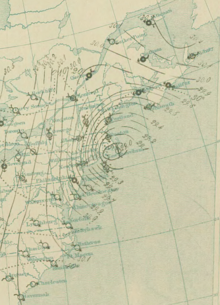
Wind is caused by differences in atmospheric pressure, which are mainly due to temperature differences. When adifference in atmospheric pressureexists, air moves from the higher to the lower pressure area, resulting in winds of various speeds. On a rotating planet, air will also be deflected by theCoriolis effect,except exactly on the equator. Globally, the two major driving factors of large-scale wind patterns (theatmospheric circulation) are the differential heating between the equator and the poles (difference in absorption ofsolar energyleading tobuoyancy forces) and therotation of the planet.Outside the tropics and aloft from frictional effects of the surface, the large-scale winds tend to approachgeostrophic balance.Near the Earth's surface,frictioncauses the wind to be slower than it would be otherwise. Surface friction also causes winds to blow more inward into low-pressure areas.[1][2]
Winds defined by an equilibrium of physical forces are used in the decomposition and analysis of wind profiles. They are useful for simplifying the atmosphericequations of motionand for making qualitative arguments about the horizontal and vertical distribution of horizontal winds. Thegeostrophic windcomponent is the result of the balance between Coriolis force and pressure gradient force. It flows parallel toisobarsand approximates the flow above theatmospheric boundary layerin the midlatitudes.[3]Thethermal windis thedifferencein the geostrophic wind between two levels in the atmosphere. It exists only in an atmosphere with horizontaltemperature gradients.[4]Theageostrophic windcomponent is the difference between actual and geostrophic wind, which is responsible for air "filling up" cyclones over time.[5]Thegradient windis similar to the geostrophic wind but also includescentrifugal force(orcentripetal acceleration).[6]
Measurement
[edit]
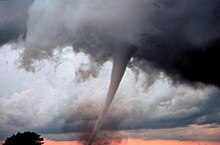
Wind directionis usually expressed in terms of the direction from which it originates. For example, anortherlywind blows from the north to the south.[7]Weather vanespivot to indicate the direction of the wind.[8]At airports,windsocksindicate wind direction, and can also be used to estimate wind speed by the angle of hang.[9]Wind speed is measured byanemometers,most commonly using rotating cups or propellers. When a high measurement frequency is needed (such as in research applications), wind can be measured by the propagation speed ofultrasoundsignals or by the effect of ventilation on the resistance of a heated wire.[10]Another type of anemometer usespitot tubesthat take advantage of the pressure differential between an inner tube and an outer tube that is exposed to the wind to determine the dynamic pressure, which is then used to compute the wind speed.[11]
Sustained wind speeds are reported globally at a 10-meter (33 ft) height and are averaged over a 10‑minute time frame. The United States reports winds over a 1‑minute average for tropical cyclones,[12]and a 2‑minute average within weather observations.[13]India typically reports winds over a 3‑minute average.[14]Knowing the wind sampling average is important, as the value of a one-minute sustained wind is typically 14% greater than a ten-minute sustained wind.[15]A short burst of high speed wind is termed awind gust;one technical definition of a wind gust is: the maxima that exceed the lowest wind speed measured during a ten-minute time interval by 10 knots (19 km/h; 12 mph) for periods of seconds. Asquallis an increase of the wind speed above a certain threshold, which lasts for a minute or more.
To determine winds aloft,radiosondesdetermine wind speed byGPS,radio navigation,orradartracking of the probe.[16]Alternatively, movement of the parentweather balloonposition can be tracked from the ground visually usingtheodolites.[17]Remote sensingtechniques for wind includeSODAR,Dopplerlidarsand radars, which can measure theDoppler shiftofelectromagnetic radiationscattered or reflected off suspendedaerosolsormolecules,andradiometersand radars can be used to measure the surface roughness of the ocean from space or airplanes. Ocean roughness can be used to estimate wind velocity close to the sea surface over oceans. Geostationary satellite imagery can be used to estimate the winds at cloud top based upon how far clouds move from one image to the next.Wind engineeringdescribes the study of the effects of the wind on the built environment, including buildings, bridges and other artificial objects.
Models
[edit]Models can provide spatial and temporal information about airflow. Spatial information can be obtained through the interpolation of data from various measurement stations, allowing for horizontal data calculation. Alternatively, profiles, such as thelogarithmic wind profile,can be utilized to derive vertical information.
Temporal information is typically computed by solving theNavier-Stokes equationswithinnumerical weather predictionmodels, generating global data forGeneral Circulation Modelsor specific regional data. The calculation of wind fields is influenced by factors such asradiationdifferentials, Earth's rotation, and friction, among others.[18]Solving the Navier-Stokes equations is a time-consuming numerical process, butmachine learningtechniques can help expedite computation time.[19]
Numerical weather prediction models have significantly advanced our understanding of atmospheric dynamics and have become indispensable tools in weather forecasting andclimateresearch. By leveraging both spatial and temporal data, these models enable scientists to analyze and predict global and regional wind patterns, contributing to our comprehension of the Earth's complex atmospheric system.
Wind force scale
[edit]Historically, theBeaufort wind force scale(created byBeaufort) provides an empirical description of wind speed based on observed sea conditions. Originally it was a 13-level scale (0–12), but during the 1940s, the scale was expanded to 18 levels (0–17).[20]There are general terms that differentiate winds of different average speeds such as a breeze, a gale, a storm, or a hurricane. Within the Beaufort scale, gale-force winds lie between 28 knots (52 km/h) and 55 knots (102 km/h) with preceding adjectives such as moderate, fresh, strong, and whole used to differentiate the wind's strength within the gale category.[21]A storm has winds of 56 knots (104 km/h) to 63 knots (117 km/h).[22]The terminology for tropical cyclones differs from one region to another globally. Most ocean basins use the average wind speed to determine the tropical cyclone's category. Below is a summary of the classifications used byRegional Specialized Meteorological Centersworldwide:
| General wind classifications | Tropical cyclone classifications (all winds are 10-minute averages) | ||||||||
|---|---|---|---|---|---|---|---|---|---|
| Beaufort scale[20] | 10-minute sustained winds | General term[23] | N Indian Ocean IMD |
SW Indian Ocean MF |
Australian region South Pacific BoM,BMKG,FMS,MSNZ |
NW Pacific JMA |
NW Pacific JTWC |
NE Pacific & N Atlantic NHC&CPHC | |
| (knots) | (km/h) | ||||||||
| 0 | <1 | <2 | Calm | Low Pressure Area | Tropical disturbance | Tropical low Tropical Depression |
Tropical depression | Tropical depression | Tropical depression |
| 1 | 1–3 | 2–6 | Light air | ||||||
| 2 | 4–6 | 7–11 | Light breeze | ||||||
| 3 | 7–10 | 13–19 | Gentle breeze | ||||||
| 4 | 11–16 | 20–30 | Moderate breeze | ||||||
| 5 | 17–21 | 31–39 | Fresh breeze | Depression | |||||
| 6 | 22–27 | 41–50 | Strong breeze | ||||||
| 7 | 28–29 | 52–54 | Moderate gale | Deep depression | Tropical depression | ||||
| 30–33 | 56–61 | ||||||||
| 8 | 34–40 | 63–74 | Fresh gale | Cyclonic storm | Moderate tropical storm | Tropical cyclone (1) | Tropical storm | Tropical storm | Tropical storm |
| 9 | 41–47 | 76–87 | Strong gale | ||||||
| 10 | 48–55 | 89–102 | Whole gale | Severe cyclonic storm | Severe tropical storm | Tropical cyclone (2) | Severe tropical storm | ||
| 11 | 56–63 | 104–117 | Storm | ||||||
| 12 | 64–72 | 119–133 | Hurricane | Very severe cyclonic storm | Tropical cyclone | Severe tropical cyclone (3) | Typhoon | Typhoon | Hurricane (1) |
| 13 | 73–85 | 135–157 | Hurricane (2) | ||||||
| 14 | 86–89 | 159–165 | Severe tropical cyclone (4) | Major hurricane (3) | |||||
| 15 | 90–99 | 167–183 | Intense tropical cyclone | ||||||
| 16 | 100–106 | 185–196 | Major hurricane (4) | ||||||
| 17 | 107–114 | 198–211 | Severe tropical cyclone (5) | ||||||
| 115–119 | 213–220 | Very intense tropical cyclone | Super typhoon | ||||||
| >120 | >222 | Super cyclonic storm | Major hurricane (5) | ||||||
Enhanced Fujita scale
[edit]TheEnhanced Fujita Scale(EF Scale) rates the strength of tornadoes by using damage to estimate wind speed. It has six levels, from visible damage to complete destruction. It is used in the United States and in some other countries, including Canada and France, with small modifications.[24]
Station model
[edit]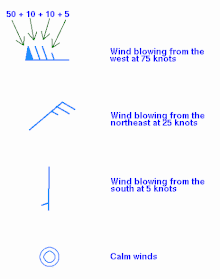
Thestation modelplotted on surfaceweather mapsuses a wind barb to show both wind direction and speed. The wind barb shows the speed using "flags" on the end.
- Each half of a flag depicts 5 knots (9.3 km/h; 5.8 mph) of wind.
- Each full flag depicts 10 knots (19 km/h; 12 mph) of wind.
- Eachpennant(filled triangle) depicts 50 knots (93 km/h; 58 mph) of wind.[25]
Winds are depicted as blowing from the direction the barb is facing. Therefore, a northeast wind will be depicted with a line extending from the cloud circle to the northeast, with flags indicating wind speed on the northeast end of this line.[26]Once plotted on a map, an analysis ofisotachs(lines of equal wind speeds) can be accomplished. Isotachs are particularly useful in diagnosing the location of thejet streamon upper-level constant pressure charts, and are usually located at or above the 300 hPa level.[27]
Global climatology
[edit]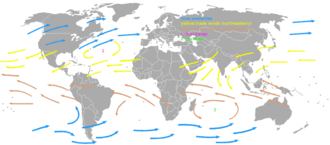

Easterly winds, on average, dominate the flow pattern across the poles, westerly winds blow across themid-latitudesof the Earth, polewards of thesubtropical ridge,while easterlies again dominate thetropics.
Directly under the subtropical ridge are the doldrums, or horse latitudes, where winds are lighter. Many of the Earth's deserts lie near the average latitude of the subtropical ridge, where descent reduces therelative humidityof the air mass.[28]The strongest winds are in the mid-latitudes where cold polar air meets warm air from the tropics.
Tropics
[edit]The trade winds (also called trades) are the prevailing pattern ofeasterlysurface winds found in the tropics towards the Earth'sequator.[29]The trade winds blow predominantly from the northeast in the Northern Hemisphere and from the southeast in the Southern Hemisphere.[30]The trade winds act as thesteering flowfortropical cyclonesthat form over the world's oceans.[31]Trade winds also steer African dust westward across the Atlantic Ocean into the Caribbean, as well as portions of southeast North America.[32]
Amonsoonis a seasonal prevailing wind that lasts for several months within tropical regions. The term was first used in English in India,Bangladesh,Pakistan, and neighboring countries to refer to the big seasonal winds blowing from theIndian OceanandArabian Seain the southwest bringing heavy rainfall to the area.[33]Its poleward progression is accelerated by the development of a heat low over the Asian, African, and North American continents during May through July, and over Australia in December.[34][35][36]
Westerlies and their impact
[edit]
The Westerlies or the Prevailing Westerlies are theprevailing windsin themiddle latitudesbetween 35 and 65 degreeslatitude.These prevailing winds blow from the west to the east,[37][38]and steer extratropical cyclones in this general manner. The winds are predominantly from the southwest in the Northern Hemisphere and from the northwest in the Southern Hemisphere.[30]They are strongest in the winter when the pressure is lower over the poles, and weakest during the summer and when pressures are higher over the poles.[39]
Together with thetrade winds,the westerlies enabled a round-trip trade route for sailing ships crossing the Atlantic and Pacific Oceans, as the westerlies lead to the development of strong ocean currents on the western sides of oceans in both hemispheres through the process ofwestern intensification.[40]These western ocean currents transport warm, sub-tropical water polewards toward thepolar regions.The westerlies can be particularly strong, especially in the southern hemisphere, where there is less land in the middle latitudes to cause the flow pattern to amplify, which slows the winds down. The strongest westerly winds in the middle latitudes are within a band known as theRoaring Forties,between40and50 degrees latitude southof the equator.[41]The Westerlies play an important role in carrying the warm, equatorial waters and winds to the western coasts of continents,[42][43]especially in the southern hemisphere because of its vast oceanic expanse.
Polar easterlies
[edit]The polar easterlies, also known as Polar Hadley cells, are dry, cold prevailing winds that blow from the high-pressure areas of thepolar highsat thenorthandSouth Polestowards the low-pressure areas within the Westerlies at high latitudes. Unlike the Westerlies, these prevailing winds blow from the east to the west, and are often weak and irregular.[44]Because of the low sun angle, cold air builds up andsubsidesat the pole creating surface high-pressure areas, forcing an equatorward outflow of air;[45]that outflow is deflected westward by the Coriolis effect.
Local considerations
[edit]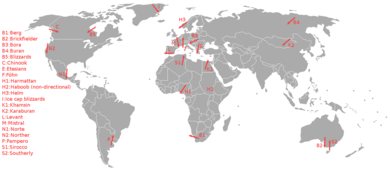
Sea and land breezes
[edit]
In coastal regions, sea breezes and land breezes can be important factors in a location's prevailing winds. The sea is warmed by the sun more slowly because of water's greaterspecific heatcompared to land. As the temperature of the surface of the land rises, the land heats the air above it by conduction. The warm air is less dense than the surrounding environment and so it rises.[46]The cooler air above the sea, now with highersea level pressure,flows inland into the lower pressure, creating a cooler breeze near the coast. A background along-shore wind either strengthens or weakens the sea breeze, depending on its orientation with respect to the Coriolis force.[47]
At night, the land cools off more quickly than the ocean because of differences in their specific heat values. This temperature change causes the daytime sea breeze to dissipate. When the temperature onshore cools below the temperature offshore, the pressure over the water will be lower than that of the land, establishing a land breeze, as long as an onshore wind is not strong enough to oppose it.[48]
Near mountains
[edit]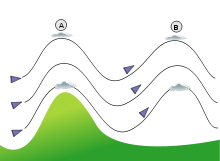
Over elevated surfaces, heating of the ground exceeds the heating of the surrounding air at the same altitude abovesea level,creating an associated thermal low over the terrain and enhancing any thermal lows that would have otherwise existed,[49][50]and changing the wind circulation of the region. In areas where there is ruggedtopographythat significantly interrupts the environmental wind flow, the wind circulation between mountains and valleys is the most important contributor to the prevailing winds. Hills and valleys substantially distort the airflow by increasing friction between the atmosphere and landmass by acting as a physical block to the flow, deflecting the wind parallel to the range just upstream of the topography, which is known as abarrier jet.This barrier jet can increase the low-level wind by 45%.[51]Wind direction also changes because of the contour of the land.[52]
If there is apassin the mountain range, winds will rush through the pass with considerable speed because of theBernoulli principlethat describes an inverse relationship between speed and pressure. The airflow can remain turbulent and erratic for some distance downwind into the flatter countryside. These conditions are dangerous to ascending and descendingairplanes.[52]Cool winds accelerating through mountain gaps have been given regional names. In Central America, examples include thePapagayo wind,thePanamawind, and theTehuano wind.In Europe, similar winds are known as theBora,Tramontane,andMistral.When these winds blow over open waters, they increase mixing of the upper layers of the ocean that elevates cool, nutrient rich waters to the surface, which leads to increased marine life.[53]
In mountainous areas, local distortion of the airflow becomes severe. Jagged terrain combines to produce unpredictable flow patterns and turbulence, such asrotors,which can be topped bylenticular clouds.Strongupdrafts,downdrafts, andeddiesdevelop as the air flows over hills and down valleys. Orographicprecipitationoccurs on thewindwardside of mountains and is caused by the rising air motion of a large-scale flow of moist air across the mountain ridge, also known as upslope flow, resulting inadiabaticcooling and condensation. In mountainous parts of the world subjected to relatively consistent winds (for example, the trade winds), a more moist climate usually prevails on the windward side of a mountain than on theleewardor downwind side. Moisture is removed by orographic lift, leaving drier air on the descending and generally warming, leeward side where arain shadowis observed.[54]
Winds that flow over mountains down into lower elevations are known as downslope winds. These winds are warm and dry. In Europe downwind of theAlps,they are known asfoehn.In Poland, an example is thehalnywiatr. In Argentina, the local name for down sloped winds iszonda.In Java, the local name for such winds is koembang. In New Zealand, they are known as theNor'west arch,and are accompanied by the cloud formation they are named after that has inspired artwork over the years.[55]In the Great Plains of the United States, these winds are known as achinook.Downslope winds also occur in the foothills of the Appalachian mountains of the United States,[56]and they can be as strong as other downslope winds[57]and unusual compared to otherfoehn windsin that the relative humidity typically changes little due to the increased moisture in the source air mass.[58]In California, downslope winds are funneled through mountain passes, which intensify their effect, and examples include theSanta Anaandsundownerwinds. Wind speeds during downslope wind effect can exceed 160 kilometers per hour (99 mph).[59]
Shear
[edit]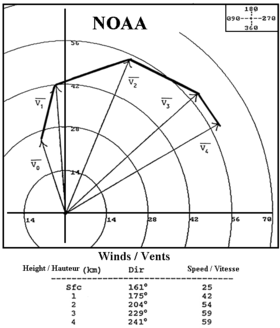
Wind shear, sometimes referred to aswind gradient,is a difference in wind speed and direction over a relatively short distance in the Earth's atmosphere.[60]Wind shear can be broken down into vertical and horizontal components, with horizontal wind shear seen acrossweather frontsand near the coast,[61]and vertical shear typically near the surface,[62]though also at higher levels in the atmosphere near upper level jets and frontal zones aloft.[63]
Wind shear itself is amicroscale meteorologicalphenomenon occurring over a very small distance, but it can be associated withmesoscaleorsynoptic scaleweather features such assquall linesandcold fronts.It is commonly observed nearmicroburstsanddownburstscaused bythunderstorms,[64]weather fronts, areas of locally higher low level winds referred to as low level jets, near mountains,[65]radiation inversions that occur because of clear skies and calm winds, buildings,[66]wind turbines,[67]andsailboats.[68]Wind shear has a significant effect on the control of aircraft during take-off and landing,[69]and was a significant cause of aircraft accidents involving large loss of life within the United States.[64]
Sound movement through the atmosphere is affected by wind shear, which can bend the wave front, causing sounds to be heard where they normally would not, or vice versa.[70]Strong vertical wind shear within the troposphere also inhibitstropical cyclonedevelopment,[71]but helps to organize individual thunderstorms into living longer life cycles that can then producesevere weather.[72]Thethermal windconcept explains how differences in wind speed with height are dependent on horizontal temperature differences, and explains the existence of thejet stream.[73]
In civilization
[edit]Religion
[edit]As a natural force, the wind was often personified as one or morewind godsor as an expression of thesupernaturalin many cultures.Vayuis theVedicand Hindu God of Wind.[74][75]The Greek wind gods includeBoreas,Notus,Eurus,andZephyrus.[75]Aeolus,in varying interpretations the ruler or keeper of the four winds, has also been described asAstraeus,the god of dusk who fathered the four winds withEos,goddess of dawn. Theancient Greeksalso observed the seasonal change of the winds, as evidenced by theTower of the WindsinAthens.[75]Venti are the Roman gods of the winds.[76]Fūjinis the Japanese wind god and is one of the eldestShintogods. According to legend, he was present at the creation of the world and first let the winds out of his bag to clear the world of mist.[77]InNorse mythology,Njörðris the god of the wind.[75]There are also four dvärgar (Norse dwarves), namedNorðri, Suðri, Austri and Vestri,and probably thefour stags of Yggdrasil,personify the four winds, and parallel the four Greek wind gods.[78]Stribogis the name of theSlavic godof winds, sky and air. He is said to be the ancestor (grandfather) of the winds of the eight directions.[75]
History
[edit]Kamikazeis a Japanese word, usually translated as divine wind, believed to be a gift from the gods. The term is first known to have been used as the name of a pair or series of typhoons that are said to have saved Japan from two Mongol fleets under Kublai Khan that attacked Japan in 1274 and again in 1281.[79]Protestant Windis a name for the storm that deterred theSpanish Armadafrom an invasion of England in 1588 where the wind played a pivotal role,[80]or the favorable winds that enabledWilliam of Orangeto invade England in 1688.[81]DuringNapoleon'sEgyptian Campaign,the French soldiers had a hard time with thekhamsinwind: when the storm appeared "as a blood-stint in the distant sky", the Ottomans went to take cover, while the French "did not react until it was too late, then choked and fainted in the blinding, suffocating walls of dust".[82]During theNorth African Campaignof the World War II, "allied and German troops were several times forced to halt in mid-battle because of sandstorms caused by khamsin... Grains of sand whirled by the wind blinded the soldiers and created electrical disturbances that rendered compasses useless."[83]
Transportation
[edit]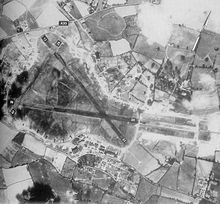
There are many different forms of sailing ships, but they all have certain basic things in common. Except forrotor shipsusing theMagnus effect,every sailing ship has ahull,riggingand at least onemastto hold up thesailsthat use the wind to power the ship.[84]Ocean journeys by sailing ship can take many months,[85]and a common hazard is becoming becalmed because of lack of wind,[86]or being blown off course by severestormsor winds that do not allow progress in the desired direction.[87]A severe storm could lead toshipwreck,and the loss of all hands.[88]Sailing ships can only carry a certain quantity of supplies in theirhold,so they have to plan longvoyagescarefully to include appropriateprovisions,including fresh water.[89]
Foraerodynamicaircraft which operate relative to the air, winds affect groundspeed,[90]and in the case of lighter-than-air vehicles, wind may play a significant or solitary role in their movement andground track.[91]Thevelocityof surface wind is generally the primary factor governing the direction of flight operations at an airport, andairfieldrunways are aligned to account for the common wind direction(s) of the local area. While taking off with atailwindmay be necessary under certain circumstances, aheadwindis generally desirable. A tailwind increases takeoff distance required and decreases the climb gradient.[92]
Power source
[edit]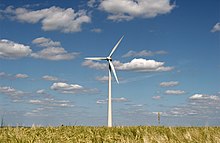
The ancientSinhaleseofAnuradhapuraand in other cities aroundSri Lankaused the monsoon winds to power furnaces as early as 300BCE.The furnaces were constructed on the path of the monsoon winds to bring the temperatures inside up to 1,200 °C (2,190 °F).[93]A rudimentarywindmillwas used to power anorganin the first century CE.[94]Windmills were later built inSistan,Afghanistan,from the 7th century CE. These were vertical-axle windmills,[95]withsailscovered inreed mattingor cloth material. These windmills were used to grind corn and draw up water, and were used in thegristmillingand sugarcane industries.[96]Horizontal-axle windmills were later used extensively in Northwestern Europe to grind flour beginning in the 1180s, and many Dutch windmills still exist.
Wind power is now one of the main sources ofrenewable energy,and its use is growing rapidly, driven by innovation and falling prices.[97]Most of the installed capacity in wind power isonshore,butoffshore wind poweroffers a large potential as wind speeds are typically higher and more constant away from the coast.[98]Wind energy thekinetic energyof the air, is proportional to the third power of wind velocity.Betz's lawdescribed the theoretical upper limit of what fraction of this energy wind turbines can extract, which is about 59%.[99]
Recreation
[edit]
Wind figures prominently in several popular sports, including recreationalhang gliding,hot air ballooning,kiteflying,snowkiting,kite landboarding,kite surfing,paragliding,sailing,andwindsurfing.In gliding, wind gradients just above the surface affect the takeoff and landing phases of flight of aglider.Wind gradient can have a noticeable effect onground launches,also known as winch launches or wire launches. If the wind gradient is significant or sudden, or both, and the pilot maintains the same pitch attitude, the indicated airspeed will increase, possibly exceeding the maximum ground launch tow speed. The pilot must adjust the airspeed to deal with the effect of the gradient.[100]When landing, wind shear is also a hazard, particularly when the winds are strong. As the glider descends through the wind gradient on final approach to landing, airspeed decreases while sink rate increases, and there is insufficient time to accelerate prior to ground contact. The pilot must anticipate the wind gradient and use a higher approach speed to compensate for it.[101]
In the natural world
[edit]In arid climates, the main source of erosion is wind.[102]The general wind circulation moves small particulates such as dust across wide oceans thousands of kilometers downwind of their point of origin,[103]which is known as deflation. Westerly winds in the mid-latitudes of the planet drive the movement of ocean currents from west to east across the world's oceans. Wind has a very important role in aiding plants and other immobile organisms in dispersal of seeds, spores, pollen, etc. Although wind is not the primary form of seed dispersal in plants, it provides dispersal for a large percentage of the biomass of land plants.
Erosion
[edit]
Erosion can be the result of material movement by the wind. There are two main effects. First, wind causes small particles to be lifted and therefore moved to another region. This is called deflation. Second, these suspended particles may impact on solid objects causing erosion by abrasion (ecological succession). Wind erosion generally occurs in areas with little or no vegetation, often in areas where there is insufficient rainfall to support vegetation. An example is the formation of sanddunes,on a beach or in a desert.[104]Loess is a homogeneous, typically nonstratified, porous,friable,slightly coherent, often calcareous, fine-grained,silty,pale yellow or buff, windblown (Aeolian)sediment.[105]It generally occurs as a widespread blanket deposit that covers areas of hundreds of square kilometers and tens of meters thick. Loess often stands in either steep or vertical faces.[106]Loess tends to develop into highly rich soils. Under appropriate climatic conditions, areas with loess are among the most agriculturally productive in the world.[107]Loess deposits are geologically unstable by nature, and will erode very readily. Therefore,windbreaks(such as big trees and bushes) are often planted by farmers to reduce the wind erosion of loess.[102]
Desert dust migration
[edit]During mid-summer (July in the northern hemisphere), the westward-moving trade winds south of the northward-moving subtropical ridge expand northwestward from the Caribbean into southeastern North America. When dust from theSaharamoving around the southern periphery of the ridge within the belt of trade winds moves over land, rainfall is suppressed and the sky changes from a blue to a white appearance, which leads to an increase in red sunsets. Its presence negatively impactsair qualityby adding to the count of airborne particulates.[108]Over 50% of the African dust that reaches the United States affects Florida.[109]Since 1970, dust outbreaks have worsened because of periods of drought in Africa. There is a large variability in the dust transport to the Caribbean and Florida from year to year.[110]Dust events have been linked to a decline in the health ofcoral reefsacross the Caribbean and Florida, primarily since the 1970s.[111]Similar dust plumes originate in theGobi Desert,which combined with pollutants, spread large distances downwind, or eastward, into North America.[103]
There are local names for winds associated with sand and dust storms. TheCalimacarries dust on southeast winds into theCanary islands.[112]TheHarmattancarries dust during the winter into theGulf of Guinea.[113]TheSiroccobrings dust from north Africa into southern Europe because of the movement of extratropical cyclones through the Mediterranean.[114]Spring storm systems moving across the eastern Mediterranean Sea cause dust to carry acrossEgyptand theArabian peninsula,which are locally known asKhamsin.[115]TheShamalis caused by cold fronts lifting dust into the atmosphere for days at a time across thePersian Gulfstates.[116]
Effect on plants
[edit]
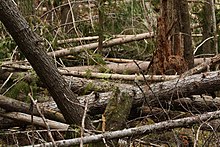
Wind dispersal of seeds, oranemochory,is one of the more primitive means of dispersal. Wind dispersal can take on one of two primary forms: seeds can float on the breeze or alternatively, they can flutter to the ground.[117]The classic examples of these dispersal mechanisms includedandelions(Taraxacumspp.,Asteraceae), which have a featherypappusattached to their seeds and can be dispersed long distances, andmaples(Acer (genus)spp.,Sapindaceae), which have winged seeds and flutter to the ground. An important constraint on wind dispersal is the need for abundant seed production to maximize the likelihood of a seed landing in a site suitable forgermination.There are also strong evolutionary constraints on this dispersal mechanism. For instance, species in the Asteraceae on islands tended to have reduced dispersal capabilities (i.e., larger seed mass and smaller pappus) relative to the same species on the mainland.[118]Reliance upon wind dispersal is common among manyweedyorruderalspecies. Unusual mechanisms of wind dispersal includetumbleweeds.A related process to anemochory isanemophily,which is the process where pollen is distributed by wind. Large families of plants are pollinated in this manner, which is favored when individuals of the dominant plant species are spaced closely together.[119]
Wind also limits tree growth. On coasts and isolated mountains, the tree line is often much lower than in corresponding altitudes inland and in larger, more complex mountain systems, because strong winds reduce tree growth. High winds scour away thinsoilsthrough erosion,[120]as well as damage limbs and twigs. When high winds knock down or uproot trees, the process is known aswindthrow.This is most likely onwindwardslopes of mountains, with severe cases generally occurring totree standsthat are 75 years or older.[121]Plant varieties near the coast, such as theSitka spruceandsea grape,[122]areprunedback by wind and salt spray near the coastline.[123]
Wind can also cause plants damage throughsand abrasion.Strong winds will pick up loose sand andtopsoiland hurl it through the air at speeds ranging from 25 miles per hour (40 km/h) to 40 miles per hour (64 km/h). Such windblown sand causes extensive damage to plant seedlings because it ruptures plant cells, making them vulnerable to evaporation and drought. Using a mechanical sandblaster in a laboratory setting, scientists affiliated with theAgricultural Research Servicestudied the effects of windblown sand abrasion on cotton seedlings. The study showed that the seedlings responded to the damage created by the windblown sand abrasion by shifting energy from stem and root growth to the growth and repair of the damaged stems.[124]After a period of four weeks, the growth of the seedling once again became uniform throughout the plant, as it was before the windblown sand abrasion occurred.[125]
Besides plant gametes (seeds) wind also helps plants' enemies:Sporesand otherpropagulesofplant pathogensare even lighter and able to travel long distances.[126]A few plant diseases are known to have been known to travel overmarginal seas[127]and even entire oceans.[128]Humans are unable to prevent or even slow down wind dispersal of plant pathogens, requiring prediction and amelioration instead.[129]
Effect on animals
[edit]Cattleandsheepare prone towind chillcaused by a combination of wind and cold temperatures, when winds exceed 40 kilometers per hour (25 mph), rendering their hair and wool coverings ineffective.[130]Althoughpenguinsuse both a layer offatandfeathersto help guard against coldness in both water and air, theirflippersand feet are less immune to the cold. In the coldest climates such asAntarctica,emperor penguinsusehuddlingbehavior to survive the wind and cold, continuously alternating the members on the outside of the assembled group, which reduces heat loss by 50%.[131]Flyinginsects,a subset ofarthropods,are swept along by the prevailing winds,[132]while birds follow their own course taking advantage of wind conditions, in order to either fly or glide.[133]As such, fine line patterns withinweather radarimagery, associated with converging winds, are dominated by insect returns.[134]Bird migration, which tends to occur overnight within the lowest 7,000 feet (2,100 m) of theEarth's atmosphere,contaminates wind profiles gathered by weather radar, particularly theWSR-88D,by increasing the environmental wind returns by 15 knots (28 km/h) to 30 knots (56 km/h).[135]
Pikasuse a wall of pebbles to store dry plants and grasses for the winter in order to protect the food from being blown away.[136]Cockroachesuse slight winds that precede the attacks of potentialpredators,such astoads,to survive their encounters. Theircerciare very sensitive to the wind, and help them survive half of their attacks.[137]Elkhave a keen sense of smell that can detect potential upwind predators at a distance of 0.5 miles (800 m).[138]Increases in wind above 15 kilometers per hour (9.3 mph) signalsglaucous gullsto increase their foraging and aerial attacks on thick-billedmurres.[139]
Related damage
[edit]
High winds are known to cause damage, depending upon the magnitude of their velocity and pressure differential. Wind pressures are positive on the windward side of a structure and negative on the leeward side. Infrequent wind gusts can cause poorly designedsuspension bridgesto sway. When wind gusts are at a similar frequency to the swaying of the bridge, the bridge can be destroyed more easily, such as what occurred with theTacoma Narrows Bridgein 1940.[140]Wind speeds as low as 23 knots (43 km/h) can lead to power outages due to tree branches disrupting the flow of energy through power lines.[141]While no species of tree is guaranteed to stand up to hurricane-force winds, those with shallow roots are more prone to uproot, and brittle trees such aseucalyptus,seahibiscus,andavocadoare more prone to damage.[142]Hurricane-force winds cause substantial damage to mobile homes, and begin to structurally damage homes with foundations. Winds of this strength due to downsloped winds off terrain have been known to shatter windows and sandblast paint from cars.[59]Once winds exceed 135 knots (250 km/h), homes completely collapse, and significant damage is done to larger buildings. Total destruction to artificial structures occurs when winds reach 175 knots (324 km/h). TheSaffir–Simpson scaleandEnhanced Fujita scalewere designed to help estimate wind speed from the damage caused by high winds related to tropical cyclones andtornadoes,and vice versa.[143][144]
Australia'sBarrow Islandholds the record for the strongest wind gust, reaching 408 km/h (253 mph) during tropicalCyclone Oliviaon 10 April 1996, surpassing the previous record of 372 km/h (231 mph) set onMount Washington (New Hampshire)on the afternoon of 12 April 1934.[145]
Wildfire intensity increases during daytime hours. For example, burn rates ofsmolderinglogs are up to five times greater during the day because of lower humidity, increased temperatures, and increased wind speeds.[146]Sunlight warms the ground during the day and causes air currents to travel uphill, and downhill during the night as the land cools. Wildfires are fanned by these winds and often follow the air currents over hills and through valleys.[147]United States wildfire operations revolve around a 24-hourfire daythat begins at 10:00 a.m. because of the predictable increase in intensity resulting from the daytime warmth.[148]
In outer space
[edit]The solar wind is quite different from a terrestrial wind, in that its origin is the Sun, and it is composed of charged particles that have escaped the Sun's atmosphere. Similar to the solar wind, theplanetary windis composed of light gases that escape planetary atmospheres. Over long periods of time, the planetary wind can radically change the composition of planetary atmospheres.
The fastest wind ever recorded came from theaccretion discof theIGR J17091-3624black hole. Its speed is 20,000,000 miles per hour (32,000,000 km/h), which is 3% of thespeed of light.[149]
Planetary wind
[edit]
The hydrodynamic wind within the upper portion of a planet's atmosphere allows light chemical elements such ashydrogento move up to theexobase,the lower limit of theexosphere,where the gases can then reachescape velocity,entering outer space without impacting other particles of gas. This type of gas loss from a planet into space is known as planetary wind.[150]Such a process overgeologic timecauses water-rich planets such as the Earth to evolve into planets likeVenus.[151]Additionally, planets with hotter lower atmospheres could accelerate the loss rate of hydrogen.[152]
Solar wind
[edit]Rather than air, the solar wind is astream of charged particles—aplasma—ejected from theupper atmosphereof the Sun at a rate of 400 kilometers per second (890,000 mph).[153]It consists mostly ofelectronsandprotonswith energies of about 1keV.The stream of particles varies in temperature and speed with the passage of time. These particles are able to escape the Sun'sgravity,in part because of the hightemperatureof thecorona,[154]but also because of high kinetic energy that particles gain through a process that is not well understood. The solar wind creates theHeliosphere,a vast bubble in theinterstellar mediumsurrounding the Solar System.[155]Planets require large magnetic fields in order to reduce the ionization of their upper atmosphere by the solar wind.[152]Other phenomena caused by the solar wind includegeomagnetic stormsthat can knock out power grids on Earth,[156]theauroraesuch as theNorthern Lights,[157]and the plasma tails ofcometsthat always point away from the Sun.[158]
On other planets
[edit]
Strong 300 kilometers per hour (190 mph) winds at Venus's cloud tops circle the planet every four to five Earth days.[159]When the poles ofMarsare exposed to sunlight after their winter, the frozen CO2sublimates,creating significant winds that sweep off the poles as fast as 400 kilometers per hour (250 mph), which subsequently transports large amounts of dust and water vapor over itslandscape.[160]Other Martian winds have resulted incleaning eventsanddust devils.[161][162]OnJupiter,wind speeds of 100 meters per second (220 mph) are common in zonal jet streams.[163]Saturn's winds are among the Solar System's fastest.Cassini–Huygensdata indicated peak easterly winds of 375 meters per second (840 mph).[164]OnUranus,northern hemisphere wind speeds reach as high as 240 meters per second (540 mph) near 50 degrees north latitude.[165][166][167]At the cloud tops ofNeptune,prevailing winds range in speed from 400 meters per second (890 mph) along the equator to 250 meters per second (560 mph) at the poles.[168]At 70° S latitude on Neptune, a high-speed jet stream travels at a speed of 300 meters per second (670 mph).[169]The fastest wind on any known planet is onHD 80606 blocated 190light yearsaway, where it blows at more than 11,000 mph or 5 km/s.[170]
See also
[edit]References
[edit]- ^JetStream (2008)."Origin of Wind".National Weather ServiceSouthern Region Headquarters. Archived fromthe originalon 2009-03-24.Retrieved2009-02-16.
- ^Makarieva, Anastassia; V. G. Gorshkov, D. Sheil, A. D. Nobre, B.-L. Li (February 2013)."Where do winds come from? A new theory on how water vapor condensation influences atmospheric pressure and dynamics".Atmospheric Chemistry and Physics.13(2): 1039–1056.arXiv:1004.0355.Bibcode:2013ACP....13.1039M.doi:10.5194/acp-13-1039-2013.Retrieved2013-02-01.
{{cite journal}}:CS1 maint: multiple names: authors list (link) - ^Glossary of Meteorology (2009)."Geostrophic wind".American Meteorological Society.Archived fromthe originalon 2007-10-16.Retrieved2009-03-18.
- ^Glossary of Meteorology (2009)."Thermal wind".American Meteorological Society. Archived fromthe originalon 2011-07-17.Retrieved2009-03-18.
- ^Glossary of Meteorology (2009)."Ageostrophic wind".American Meteorological Society. Archived fromthe originalon 2011-09-17.Retrieved2009-03-18.
- ^Glossary of Meteorology (2009)."Gradient wind".American Meteorological Society. Archived fromthe originalon 2008-05-28.Retrieved2009-03-18.
- ^JetStream (2008)."How to read weather maps".National Weather Service. Archived fromthe originalon 2012-07-05.Retrieved2009-05-16.
- ^Glossary of Meteorology (2009)."Wind vane".American Meteorological Society. Archived fromthe originalon 2007-10-18.Retrieved2009-03-17.
- ^Glossary of Meteorology (2009)."Wind sock".American Meteorological Society. Archived fromthe originalon 2012-05-14.Retrieved2009-03-17.
- ^Glossary of Meteorology (2009)."Anemometer".American Meteorological Society. Archived fromthe originalon 2011-06-06.Retrieved2009-03-17.
- ^Glossary of Meteorology (2009)."Pitot tube".American Meteorological Society. Archived fromthe originalon 2012-05-14.Retrieved2009-03-17.
- ^Tropical Cyclone Weather Services Program (2006-06-01)."Tropical cyclone definitions"(PDF).National Weather Service.Retrieved2006-11-30.
- ^Office of the Federal Coordinator for Meteorology.Federal Meteorological Handbook No. 1 – Surface Weather Observations and Reports September 2005Appendix A: Glossary. Retrieved 2008-04-06.
- ^Sharad K. Jain; Pushpendra K. Agarwal; Vijay P. Singh (2007).Hydrology and Water Resources of India.Springer. p. 187.ISBN978-1-4020-5179-1.Retrieved2009-04-22.
- ^Jan-Hwa Chu (1999)."Section 2. Intensity Observation and Forecast Errors".United States Navy.Archived fromthe originalon 2012-08-30.Retrieved2008-07-04.
- ^Glossary of Meteorology (2009)."Rawinsonde".American Meteorological Society. Archived fromthe originalon 2011-06-06.Retrieved2009-03-17.
- ^Glossary of Meteorology (2009)."Pibal".American Meteorological Society. Archived fromthe originalon 2007-11-10.Retrieved2009-03-17.
- ^Lorenc, A. C. (1986)."Analysis methods for numerical weather prediction".Quarterly Journal of the Royal Meteorological Society.112(474): 1177–1194.Bibcode:1986QJRMS.112.1177L.doi:10.1002/qj.49711247414.ISSN0035-9009.
- ^BenMoshe, Nir; Fattal, Eyal; Leitl, Bernd; Arav, Yehuda (2023-06-07)."Using Machine Learning to Predict Wind Flow in Urban Areas".Atmosphere.14(6): 990.Bibcode:2023Atmos..14..990B.doi:10.3390/atmos14060990.ISSN2073-4433.
- ^abWalter J. Saucier (2003).Principles of Meteorological Analysis.Courier Dover Publications.ISBN978-0-486-49541-5.Retrieved2009-01-09.
- ^Glossary of Meteorology (2009)."G".American Meteorological Society. Archived fromthe originalon 2012-10-05.Retrieved2009-03-18.
- ^Glossary of Meteorology (2009)."Storm".American Meteorological Society. Archived fromthe originalon 2007-10-15.Retrieved2009-03-18.
- ^Coastguard Southern Region (2009)."The Beaufort Wind Scale".Archived fromthe originalon 2008-11-18.Retrieved2009-03-18.
- ^"Enhanced Fujita Scale".American Meteorological Society - Glossary of Meteorology.7 November 2013.Retrieved21 June2021.
- ^"Decoding the station model".Hydrometeorological Prediction Center.National Centers for Environmental Prediction.2009.Retrieved2007-05-16.
- ^"How to read weather maps".JetStream.National Weather Service. 2008. Archived fromthe originalon 2012-07-05.Retrieved2009-06-27.
- ^Terry T. Lankford (2000).Aviation Weather Handbook.McGraw-Hill Professional.ISBN978-0-07-136103-3.Retrieved2008-01-22.
- ^Michael A. Mares (1999).Encyclopedia of Deserts.University of Oklahoma Press. p. 121.ISBN978-0-8061-3146-7.Retrieved2009-06-20.
- ^Glossary of Meteorology (2000)."trade winds".American Meteorological Society. Archived fromthe originalon 2008-12-11.Retrieved2008-09-08.
- ^abRalph Stockman TarrandFrank Morton McMurry(1909).Advanced geography.W.W. Shannon, State Printing. p.246.Retrieved2009-04-15.
- ^Joint Typhoon Warning Center(2006)."3.3 JTWC Forecasting Philosophies"(PDF).United States Navy. Archived fromthe original(PDF)on 2012-07-05.Retrieved2007-02-11.
- ^"African Dust Called A Major Factor Affecting Southeast U.S. Air Quality".Science Daily.1999-07-14.Retrieved2007-06-10.
- ^Glossary of Meteorology (2009)."Monsoon".American Meteorological Society. Archived fromthe originalon 2008-03-22.Retrieved2008-03-14.
- ^"Chapter-II Monsoon-2004: Onset, Advancement and Circulation Features"(PDF).National Centre for Medium Range Forecasting. 2004-10-23. Archived fromthe original(PDF)on 2011-07-21.Retrieved2008-05-03.
- ^"Monsoon".Australian Broadcasting Corporation. 2000. Archived fromthe originalon 2001-02-23.Retrieved2008-05-03.
- ^Alex DeCaria (2007-10-02)."Lesson 4 – Seasonal-mean Wind Fields"(PDF).Millersville Meteorology.Retrieved2008-05-03.
- ^Glossary of Meteorology (2009)."Westerlies".American Meteorological Society. Archived fromthe originalon 2010-06-22.Retrieved2009-04-15.
- ^Sue Ferguson (2001-09-07)."Climatology of the Interior Columbia River Basin"(PDF).Interior Columbia Basin Ecosystem Management Project. Archived fromthe original(PDF)on 2009-05-15.Retrieved2009-09-12.
- ^Halldór Björnsson (2005)."Global circulation".Veðurstofu Íslands. Archived fromthe originalon 2011-08-07.Retrieved2008-06-15.
- ^National Environmental Satellite, Data, and Information Service(2009)."Investigating the Gulf Stream".North Carolina State University.Archived fromthe originalon 2010-05-03.Retrieved2009-05-06.
{{cite web}}:CS1 maint: multiple names: authors list (link) - ^Stuart Walker (1998).The sailor's wind.W. W. Norton & Company.p.91.ISBN978-0-393-04555-0.Retrieved2009-06-17.
Roaring Forties Shrieking Sixties westerlies.
- ^Barbie Bischof; Arthur J. Mariano; Edward H. Ryan (2003)."The North Atlantic Drift Current".TheNational Oceanographic Partnership Program.Retrieved2008-09-10.
- ^Erik A. Rasmussen; John Turner (2003).Polar Lows.Cambridge University Press. p. 68.
- ^Glossary of Meteorology (2009)."Polar easterlies".American Meteorological Society. Archived fromthe originalon 2012-07-12.Retrieved2009-04-15.
- ^Michael E. Ritter (2008)."The Physical Environment: Global scale circulation".University of Wisconsin–Stevens Point.Archived fromthe originalon 2009-05-06.Retrieved2009-04-15.
- ^Steve Ackerman (1995)."Sea and Land Breezes".University of Wisconsin.Retrieved2006-10-24.
- ^Steele, C. J.; Dorling, S. R.; Glasow, R. von; Bacon, J. (2015)."Modelling sea-breeze climatologies and interactions on coasts in the southern North Sea: implications for offshore wind energy".Quarterly Journal of the Royal Meteorological Society.141(690): 1821–1835.Bibcode:2015QJRMS.141.1821S.doi:10.1002/qj.2484.ISSN1477-870X.S2CID119993890.
- ^JetStream: An Online School For Weather (2008)."The Sea Breeze".National Weather Service. Archived fromthe originalon 2006-09-23.Retrieved2006-10-24.
- ^National Weather Service Forecast Office inTucson, Arizona(2008)."What is a monsoon?".National Weather Service Western Region Headquarters.Retrieved2009-03-08.
- ^Douglas G. Hahn andSyukuro Manabe(1975)."The Role of Mountains in the South Asian Monsoon Circulation".Journal of the Atmospheric Sciences.32(8): 1515–1541.Bibcode:1975JAtS...32.1515H.doi:10.1175/1520-0469(1975)032<1515:TROMIT>2.0.CO;2.
- ^J. D. Doyle (1997)."The influence of mesoscale orography on a coastal jet and rainband".Monthly Weather Review.125(7): 1465–1488.Bibcode:1997MWRv..125.1465D.doi:10.1175/1520-0493(1997)125<1465:TIOMOO>2.0.CO;2.
- ^abNational Center for Atmospheric Research (2006)."T-REX: Catching the Sierra's waves and rotors".University Corporation for Atmospheric Research. Archived fromthe originalon 2006-11-21.Retrieved2006-10-21.
- ^Anthony Drake (2008-02-08)."The Papaguayo Wind".NASAGoddard Earth Sciences Data and Information Services Center. Archived fromthe originalon 2009-06-14.Retrieved2009-06-16.
- ^Michael Pidwirny (2008)."CHAPTER 8: Introduction to the Hydrosphere (e). Cloud Formation Processes".Physical Geography. Archived fromthe originalon 2008-12-20.Retrieved2009-01-01.
- ^Michael Dunn (2003).New Zealand Painting.Auckland University Press. p. 93.ISBN978-1-86940-297-6.Retrieved2009-06-21.
- ^David M. Gaffin (2007)."Foehn Winds That Produced Large Temperature Differences near the Southern Appalachian Mountains".Weather and Forecasting.22(1): 145–159.Bibcode:2007WtFor..22..145G.CiteSeerX10.1.1.549.7012.doi:10.1175/WAF970.1.S2CID120049170.
- ^David M. Gaffin (2009)."On High Winds and Foehn Warming Associated with Mountain-Wave Events in the Western Foothills of the Southern Appalachian Mountains".Weather and Forecasting.24(1): 53–75.Bibcode:2009WtFor..24...53G.doi:10.1175/2008WAF2007096.1.
- ^David M. Gaffin (2002)."Unexpected Warming Induced by Foehn Winds in the Lee of the Smoky Mountains".Weather and Forecasting.17(4): 907–915.Bibcode:2002WtFor..17..907G.doi:10.1175/1520-0434(2002)017<0907:UWIBFW>2.0.CO;2.
- ^abRene Munoz (2000-04-10)."Boulder's downslope winds".University Corporation for Atmospheric Research. Archived fromthe originalon 2012-03-19.Retrieved2009-06-16.
- ^D. C. Beaudette (1988)."FAA Advisory Circular Pilot Wind Shear Guide via the Internet Wayback Machine"(PDF).Federal Aviation Administration.Archived fromthe original(PDF)on 2006-10-14.Retrieved2009-03-18.
- ^David M. Roth (2006)."Unified Surface Analysis Manual"(PDF).Hydrometeorological Prediction Center.Retrieved2006-10-22.
- ^Glossary of Meteorology (2007)."E".American Meteorological Society. Archived fromthe originalon 2012-07-12.Retrieved2007-06-03.
- ^"Jet Streams in the UK".BBC. 2009. Archived fromthe originalon 2009-02-14.Retrieved2009-06-20.
- ^abCheryl W. Cleghorn (2004)."Making the Skies Safer From Windshear".NASALangley Air Force Base.Archived fromthe originalon August 23, 2006.Retrieved2006-10-22.
- ^National Center for Atmospheric Research(Spring 2006)."T-REX: Catching the Sierra's waves and rotors".University Corporation for Atmospheric Research Quarterly.Archived fromthe originalon 2009-02-21.Retrieved2009-06-21.
- ^Hans M. Soekkha (1997).Aviation Safety.VSP. p. 229.ISBN978-90-6764-258-3.Retrieved2009-06-21.
- ^Robert Harrison (2001).Large Wind Turbines.Chichester:John Wiley & Sons.p. 30.ISBN978-0-471-49456-0.
- ^Ross Garrett (1996).The Symmetry of Sailing.Dobbs Ferry:Sheridan House. pp.97–99.ISBN978-1-57409-000-0.
- ^Gail S. Langevin (2009)."Wind Shear".National Aeronautic and Space Administration.Archived fromthe originalon October 9, 2007.Retrieved2007-10-09.
- ^Rene N. Foss (June 1978).Ground Plane Wind Shear Interaction on Acoustic Transmission(Report). WA-RD 033.1. Washington State Department of Transportation.Retrieved2007-05-30.
- ^University of Illinois (1999)."Hurricanes".Retrieved2006-10-21.
- ^University of Illinois (1999)."Vertical Wind Shear".Archived fromthe originalon 2019-03-16.Retrieved2006-10-21.
- ^Integrated Publishing (2007)."Unit 6—Lesson 1: Low-Level Wind Shear".Retrieved2009-06-21.
- ^Laura Gibbs (2007-10-16)."Vayu".Encyclopedia for Epics of Ancient India.Retrieved2009-04-09.
- ^abcdeMichael Jordan (1993).Encyclopedia of Gods: Over 2, 500 Deities of the World.New York: Facts on File. pp.5, 45, 80, 187–188, 243, 280, 295.ISBN978-0-8160-2909-9.
- ^Theoi Greek Mythology (2008)."Anemi: Greek Gods of the Winds".Aaron Atsma.Retrieved2009-04-10.
- ^John Boardman (1994).The Diffusion of Classical Art in Antiquity.Princeton University Press.ISBN978-0-691-03680-9.
- ^Andy Orchard (1997).Dictionary of Norse Myth and Legend.Cassell.ISBN978-0-304-36385-8.
- ^History Detectives (2008)."Feature – Kamikaze Attacks".PBS.Archived fromthe originalon 2008-10-25.Retrieved2009-03-21.
- ^Colin Martin; Geoffrey Parker (1999).The Spanish Armada.Manchester University Press. pp. 144–181.ISBN978-1-901341-14-0.Retrieved2009-06-20.
- ^S. Lindgrén & J. Neumann (1985)."Great Historical Events That Were Significantly Affected by the Weather: 7," Protestant Wind "—" Popish Wind ": The Revolusion of 1688 in England".Bulletin of the American Meteorological Society.66(6): 634–644.Bibcode:1985BAMS...66..634L.doi:10.1175/1520-0477(1985)066<0634:GHETWS>2.0.CO;2.
- ^Nina Burleigh (2007).Mirage.Harper. p.135.ISBN978-0-06-059767-2.
- ^Jan DeBlieu (1998).Wind.Houghton Mifflin Harcourt. p.57.ISBN978-0-395-78033-6.
- ^Ernest Edwin Speight & Robert Morton Nance (1906).Britain's Sea Story, B.C. 55-A.D. 1805.Hodder and Stoughton.p.30.Retrieved2009-03-19.
structure of sailing ship.
- ^Brandon Griggs & Jeff King (2009-03-09)."Boat made of plastic bottles to make ocean voyage".CNN.Retrieved2009-03-19.
- ^Jerry Cardwell (1997).Sailing Big on a Small Sailboat.Sheridan House, Inc. p.118.ISBN978-1-57409-007-9.Retrieved2009-03-19.
- ^Brian Lavery & Patrick O'Brian (1989).Nelson's navy.Naval Institute Press. p. 191.ISBN978-1-59114-611-7.Retrieved2009-06-20.
- ^Underwater Archaeology Kids' Corner (2009)."Shipwrecks, Shipwrecks Everywhere".Wisconsin Historical Society.Archived fromthe originalon 2008-05-13.Retrieved2009-03-19.
- ^Carla Rahn Phillips (1993).The Worlds of Christopher Columbus.Cambridge University Press. p. 67.ISBN978-0-521-44652-5.Retrieved2009-03-19.
- ^Tom Benson (2008)."Relative Velocities: Aircraft Reference".NASAGlenn Research Center.Retrieved2009-03-19.
- ^Library of Congress(2006-01-06)."The Dream of Flight".Library of Congress.Archived fromthe originalon 2009-07-28.Retrieved2009-06-20.
- ^"Flight Paths"(PDF).Bristol International Airport.2004. Archived fromthe original(PDF)on 2009-03-26.Retrieved2009-03-19.
- ^G. Juleff (1996). "An ancient wind powered iron smelting technology in Sri Lanka".Nature.379(3): 60–63.Bibcode:1996Natur.379...60J.doi:10.1038/379060a0.S2CID205026185.
- ^A. G. Drachmann(1961). "Heron's Windmill".Centaurus.7(2): 145–151.Bibcode:1960Cent....7..145R.doi:10.1111/j.1600-0498.1960.tb00263.x.
- ^Ahmad Y HassanandDonald Routledge Hill(1986).Islamic Technology: An illustrated history.Cambridge University Press. p.54.ISBN978-0-521-42239-0.
- ^Donald Routledge Hill(May 1991). "Mechanical Engineering in the Medieval Near East".Scientific American.264(5): 64–69.Bibcode:1991SciAm.264e.100H.doi:10.1038/scientificamerican0591-100.
- ^IRENA."Wind energy".International Renewable Energy Agency.Retrieved2021-06-20.
- ^Kutscher, Charles F.; Milford, Jana B.; Kreith, Frank (2019).Principles of Sustainable Energy Systems, Third Edition(3rd ed.). Boca Raton, FL: Taylor & Francis Group. p. 34.ISBN978-0-429-48558-9.OCLC1082243945.
- ^The Physics of Wind Turbines.Kira Grogg Carleton College (2005) p. 8. (PDF). Retrieved 2011-11-03.
- ^Glider Flying Handbook.U.S. Government Printing Office, Washington, D.C.: U.S. Federal Aviation Administration. 2003. pp. 7–16. FAA-8083-13_GFH. Archived fromthe originalon 2005-12-18.Retrieved2009-06-17.
- ^Derek Piggott (1997).Gliding: a Handbook on Soaring Flight.Knauff & Grove. pp. 85–86, 130–132.ISBN978-0-9605676-4-5.
- ^abVern Hofman & Dave Franzen (1997)."Emergency Tillage to Control Wind Erosion".North Dakota State UniversityExtension Service.Retrieved2009-03-21.
- ^abJames K. B. Bishop; Russ E. Davis; Jeffrey T. Sherman (2002)."Robotic Observations of Dust Storm Enhancement of Carbon Biomass in the North Pacific"(PDF).Science.298(5594): 817–821.Bibcode:2002Sci...298..817B.doi:10.1126/science.1074961.PMID12399588.S2CID38762011.Archived fromthe original(PDF)on 2010-06-01.Retrieved2009-06-20.
- ^United States Geological Survey(2004)."Dunes – Getting Started".Archived fromthe originalon 2009-07-26.Retrieved2009-03-21.
- ^F. von Richthofen (1882)."On the mode of origin of the loess".Geological Magazine (Decade II).9(7): 293–305.Bibcode:1882GeoM....9..293R.doi:10.1017/S001675680017164X.S2CID131245730.
- ^K.E.K. Neuendorf; J.P. Mehl, Jr. & J.A. Jackson (2005).Glossary of Geology.Springer-Verlag,New York. p. 779.ISBN978-3-540-27951-8.
- ^Arthur Getis; Judith Getis and Jerome D. Fellmann (2000).Introduction to Geography, Seventh Edition.McGraw-Hill.p.99.ISBN978-0-697-38506-2.
- ^Science Daily (1999-07-14)."African Dust Called A Major Factor Affecting Southeast U.S. Air Quality".Retrieved2007-06-10.
- ^Science Daily (2001-06-15)."Microbes And The Dust They Ride In On Pose Potential Health Risks".Retrieved2007-06-10.
- ^Usinfo.state.gov (2003)."Study Says African Dust Affects Climate in U.S., Caribbean"(PDF).Archived fromthe original(PDF)on 2007-06-20.Retrieved2007-06-10.
- ^U. S. Geological Survey(2006)."Coral Mortality and African Dust".Archived fromthe originalon 2012-05-02.Retrieved2007-06-10.
- ^Weather Online (2009)."Calima".Retrieved2009-06-17.
- ^Henrik Breuning-Madsen and Theodore W. Awadzi (2005). "Harmattan dust deposition and particle size in Ghana".Catena.63(1): 23–38.Bibcode:2005Caten..63...23B.doi:10.1016/j.catena.2005.04.001.
- ^Weather Online (2009)."Sirocco (Scirocco)".Retrieved2009-06-17.
- ^Bill Giles (O.B.E) (2009)."The Khamsin".BBC. Archived fromthe originalon 2009-03-13.Retrieved2009-06-17.
- ^Thomas J. Perrone (August 1979)."Table of Contents: Wind Climatology of the Winter Shamal".United States Navy. Archived fromthe originalon 2010-05-06.Retrieved2009-06-17.
- ^J. Gurevitch; S. M. Scheiner & G. A. Fox (2006).Plant Ecology, 2nd ed.Sinauer Associates, Inc., Massachusetts.
- ^M. L. Cody; J. M. Overton (1996). "Short-term evolution of reduced dispersal in island plant populations".Journal of Ecology.84(1): 53–61.Bibcode:1996JEcol..84...53C.doi:10.2307/2261699.JSTOR2261699.
- ^A. J. Richards (1997).Plant Breeding Systems.Taylor & Francis. p. 88.ISBN978-0-412-57450-4.Retrieved2009-06-19.
- ^Leif Kullman (2005)."Wind-Conditioned 20th Century Decline of Birch Treeline Vegetation in the Swedish Scandes"(PDF).Arctic.58(3): 286–294.doi:10.14430/arctic430.Retrieved2009-06-20.
- ^Mathieu Bouchard; David Pothier & Jean-Claude Ruel (2009). "Stand-replacing windthrow in the boreal forests of eastern Quebec".Canadian Journal of Forest Research.39(2): 481–487.doi:10.1139/X08-174.
- ^Michael A. Arnold (2009)."Coccoloba uvifera"(PDF).Texas A&M University.Archived fromthe original(PDF)on 2011-06-06.Retrieved2009-06-20.
- ^National Park Service(2006-09-01)."Plants".Department of the Interior.Retrieved2009-06-20.
- ^ARS Studies Effect of Wind Sandblasting on Cotton Plants / January 26, 2010 / News from the USDA Agricultural Research Service.Ars.usda.gov. Retrieved 2011-11-03.
- ^"ARS Studies Effect of Wind Sandblasting on Cotton Plants".USDA Agricultural Research Service. January 26, 2010.
- ^Wilson, Richard A.; Talbot, Nicholas J. (2009). "Under pressure: investigating the biology of plant infection byMagnaporthe oryzae".Nature Reviews Microbiology.7(3).Nature Portfolio:185–195.doi:10.1038/nrmicro2032.ISSN1740-1526.PMID19219052.S2CID42684382.
- ^Morin, Louise (2020-08-25). "Progress in Biological Control of Weeds with Plant Pathogens".Annual Review of Phytopathology.58(1).Annual Reviews:201–223.doi:10.1146/annurev-phyto-010820-012823.ISSN0066-4286.PMID32384863.S2CID218563372.
- ^"Gone with the wind: Revisiting stem rust dispersal between southern Africa and Australia".GlobalRust.Retrieved2022-01-03.
- ^McDonald, Bruce A.; Linde, Celeste (2002). "The population genetics of plant pathogens and breeding strategies for durable resistance".Euphytica.124(2).Springer:163–180.doi:10.1023/a:1015678432355.ISSN0014-2336.S2CID40941822.
- ^D. R. Ames & L. W. lnsley (1975). "Wind Chill Effect for Cattle and Sheep".Journal of Animal Science.40(1): 161–165.doi:10.2527/jas1975.401161x.hdl:2097/10789.PMID1110212.
- ^Australian Antarctic Division (2008-12-08)."Adapting to the Cold".Australian Government Department of the Environment, Water, Heritage, and the Arts Australian Antarctic Division. Archived fromthe originalon 2009-06-15.Retrieved2009-06-20.
- ^Diana Yates (2008)."Birds migrate together at night in dispersed flocks, new study indicates".University of Illinoisat Urbana – Champaign.Retrieved2009-04-26.
- ^Gary Ritchison (2009-01-04)."BIO 554/754 Ornithology Lecture Notes 2 – Bird Flight I".Eastern Kentucky University.Retrieved2009-06-19.
- ^Bart Geerts & Dave Leon (2003)."P5A.6 Fine-Scale Vertical Structure of a Cold Front As Revealed By Airborne 95 GHZ Radar"(PDF).University of Wyoming.Retrieved2009-04-26.
- ^Thomas A. Niziol (August 1998)."Contamination of WSR-88D VAD Winds Due to Bird Migration: A Case Study"(PDF).Eastern Region WSR-88D Operations Note No. 12.Retrieved2009-04-26.
- ^Jennifer Owen(1982).Feeding strategy.University of Chicago Press. pp.34–35.ISBN978-0-226-64186-7.
- ^Robert C. Eaton (1984).Neural mechanisms of startle behavior.Springer. pp. 98–99.ISBN978-0-306-41556-2.Retrieved2009-06-19.
- ^Bob Robb; Gerald Bethge; Gerry Bethge (2000).The Ultimate Guide to Elk Hunting.Globe Pequot. p. 161.ISBN978-1-58574-180-9.Retrieved2009-06-19.
- ^H. G. Gilchrist; A. J. Gaston & J. N. M. Smith (1998). "Wind and prey nest sites as foraging constraints on an avian predator, the glaucous gull".Ecology.79(7): 2403–2414.doi:10.1890/0012-9658(1998)079[2403:WAPNSA]2.0.CO;2.JSTOR176831.
- ^T. P. Grazulis (2001).The tornado.University of OklahomaPress. pp.126–127.ISBN978-0-8061-3258-7.Retrieved2009-05-13.
- ^Hans Dieter Betz; Ulrich Schumann; Pierre Laroche (2009).Lightning: Principles, Instruments and Applications.Springer. pp. 202–203.ISBN978-1-4020-9078-3.Retrieved2009-05-13.
- ^Derek Burch (2006-04-26)."How to Minimize Wind Damage in the South Florida Garden".University of Florida.Retrieved2009-05-13.
- ^National Hurricane Center(2006-06-22)."Saffir-Simpson Hurricane Scale Information".National Oceanic and Atmospheric Administration.Retrieved2007-02-25.
- ^"Enhanced F Scale for Tornado Damage".Storm Prediction Center.RetrievedJune 21,2009.
- ^"Info note No.58 — World Record Wind Gust: 408 km/h".World Meteorological Association. 2010-01-22. Archived fromthe originalon 2013-01-20.
- ^Feranando de Souza Costa & David Sandberg (2004)."Mathematical model of a smoldering log"(PDF).Combustion and Flame.139(3): 227–238 [228].Bibcode:2004CoFl..139..227D.doi:10.1016/j.combustflame.2004.07.009.S2CID10499171.Retrieved2009-02-06.
- ^National Wildfire Coordinating Group (2007-02-08).NWCG Communicator's Guide for Wildland Fire Management: Fire Education, Prevention, and Mitigation Practices, Wildland Fire Overview(PDF).p. 5. Archived fromthe original(PDF)on 2016-03-04.Retrieved2008-12-11.
- ^National Wildfire Coordinating Group (2008).Glossary of Wildland Fire Terminology(PDF).p. 73. Archived fromthe original(PDF)on 2008-08-21.Retrieved2008-12-18.
- ^Ashley King; et al. (February 21, 2012)."Chandra Finds Fastest Winds from Stellar Black Hole".NASA.RetrievedSeptember 27,2012.
- ^Ruth Murray-Clay (2008)."Atmospheric Escape Hot Jupiters & Interactions Between Planetary and Stellar Winds"(PDF).Boston University.Archived fromthe original(PDF)on 2009-08-04.Retrieved2009-05-05.
- ^E. Chassefiere (1996). "Hydrodynamic escape of hydrogen from a hot water-rich atmosphere: The case of Venus".Journal of Geophysical Research.101(11): 26039–26056.Bibcode:1996JGR...10126039C.doi:10.1029/96JE01951.
- ^abRudolf Dvořák (2007).Extrasolar Planets.Wiley-VCH. pp. 139–140.ISBN978-3-527-40671-5.Retrieved2009-05-05.
- ^"Solar Wind | NOAA / NWS Space Weather Prediction Center".www.swpc.noaa.gov.Retrieved2023-05-16.
- ^David H. Hathaway (2007)."The Solar Wind".National Aeronautic and Space AdministrationMarshall Space Flight Center.Retrieved2009-03-19.
- ^Robert Roy Britt (2000-03-15). "A Glowing Discovery at the Forefront of Our Plunge Through Space". SPACE.com.
- ^John G. Kappenman; et al. (1997)."Geomagnetic Storms Can Threaten Electric Power Grid".Earth in Space.9(7): 9–11. Archived fromthe originalon 2008-06-11.Retrieved2009-03-19.
- ^T. Neil Davis (1976-03-22)."Cause of the Aurora".Alaska Science Forum. Archived fromthe originalon 2012-05-03.Retrieved2009-03-19.
- ^Donald K. Yeomans (2005)."World Book at NASA: Comets".National Aeronautics and Space Administration.Archived fromthe originalon 2015-03-21.Retrieved2009-06-20.
- ^W. B. Rossow, A. D. del Genio, T. Eichler (1990)."Cloud-tracked winds from Pioneer Venus OCPP images".Journal of the Atmospheric Sciences.47(17): 2053–2084.Bibcode:1990JAtS...47.2053R.doi:10.1175/1520-0469(1990)047<2053:CTWFVO>2.0.CO;2.
{{cite journal}}:CS1 maint: multiple names: authors list (link) - ^NASA (2004-12-13)."Mars Rovers Spot Water-Clue Mineral, Frost, Clouds".Retrieved2006-03-17.
- ^NASA – NASA Mars Rover Churns Up Questions With Sulfur-Rich Soil.Nasa.gov. Retrieved 2011-11-03.
- ^David, Leonard (12 March 2005)."Spirit Gets A Dust Devil Once-Over".Space.com.Retrieved2006-12-01.
- ^A. P. Ingersoll; T. E. Dowling; P. J. Gierasch; G. S. Orton; P. L. Read; A. Sanchez-Lavega; A. P. Showman; A. A. Simon-Miller; A. R. Vasavada (2003-07-29).Dynamics of Jupiter's Atmosphere(PDF).Lunar & Planetary Institute.Retrieved2007-02-01.
- ^C.C. Porco; et al. (2005)."Cassini Imaging Science: Initial Results on Saturn's Atmosphere".Science.307(5713): 1243–1247.Bibcode:2005Sci...307.1243P.doi:10.1126/science.1107691.PMID15731441.S2CID9210768.
- ^L. A. Sromovsky & P. M. Fry (2005). "Dynamics of cloud features on Uranus".Icarus.179(2): 459–484.arXiv:1503.03714.Bibcode:2005Icar..179..459S.doi:10.1016/j.icarus.2005.07.022.
- ^H.B. Hammel; I. de Pater; S. Gibbard; G.W. Lockwoodd; K. Rages (2005)."Uranus in 2003: Zonal winds, banded structure, and discrete features"(PDF).Icarus.175(2): 534–545.Bibcode:2005Icar..175..534H.doi:10.1016/j.icarus.2004.11.012.Archived fromthe original(PDF)on 2007-10-25.Retrieved2009-06-15.
- ^H.B. Hammel; K. Rages; G.W. Lockwoodd; E. Karkoschka; I. de Pater (2001). "New Measurements of the Winds of Uranus".Icarus.153(2): 229–235.Bibcode:2001Icar..153..229H.doi:10.1006/icar.2001.6689.
- ^Linda T. Elkins-Tanton (2006).Uranus, Neptune, Pluto, and the Outer Solar System.New York: Chelsea House. pp.79–83.ISBN978-0-8160-5197-7.
- ^Jonathan I. Lunine (1993). "The Atmospheres of Uranus and Neptune".Annual Review of Astronomy and Astrophysics.31:217–263.Bibcode:1993ARA&A..31..217L.doi:10.1146/annurev.aa.31.090193.001245.
- ^"Exoplanet Sees Extreme Heat Waves".Space.com.28 January 2009. Archived fromthe originalon 3 June 2009.Retrieved2 September2017.
